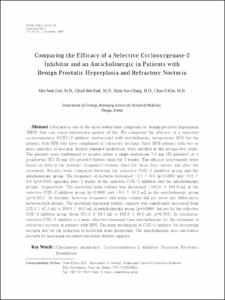Comparing the Efficacy of a Selective Cyclooxygenase-2 Inhibitor and an Anticholinergic in Patients with Benign Prostatic Hyperplasia and Refractory Nocturia
- Alternative Author(s)
- Park, Choal Hee; Chang, Hyuk Soo; Kim, Chun Il
- Journal Title
- Keimyung Medical Journal
- Issued Date
- 2009
- Abstract
- Nocturia is one of the most bothersome symptoms of benign prostatic hyperplasia (BPH) that can cause deteriorate quality of life. We compared the efficacy of a selective cyclooxygenase (COX)-2 inhibitor (meloxicam) with anticholinergic (propiverine HCl) for the patients with BPH who have complained of refractory nocturia. Sixty BPH patients with two or more episodes of nocturia, despite standard medication, were enrolled in this prospective study. The patients were randomized to receive either a single meloxicam 7.5 mg (32 patients) or a propiverine HCl 20 mg (28 patients) before sleep for 2 weeks. The efficacy assessments were based on data in the patients' frequency-volume chart for three days before and after the treatment. Results were compared between the selective COX-2 inhibitor group and the anticholinergic group. The frequency of nocturia decreased -1.7 ± 0.8 (p=0.000) and -0.9 ± 0.9 (p=0.000) episodes after 2 weeks in the selective COX-2 inhibitor and the anticholinergic
groups, respectively. The nocturnal urine volume was decreased -163.6 ± 194.9 mL in the selective COX-2 inhibitor group (p=0.000) and -9.4 ± 45.2 mL in the anticholinergic group (p=0.281). At daytime, however frequency and urine volume did not show any differences between both groups. The nocturnal functional bladder capacity was significantly increased from 223.2 ± 41.5 mL to 269.6 ± 48.5 mL in anticholinergic group (p=0.000), but not for the selective COX-2 inhibitor group (from 254.4 ± 39.4 mL to 261.5 ± 48.6 mL, p=0.281). In conclusion,
selective COX-2 inhibitor is a more effective treatment than anticholinergic for the treatment of
refractory nocturia in patients with BPH. The main mechanism of COX-2 inhibitor for decreasing
nocturia may be the reduction of nocturnal urine production. The anticholinergic also can reduce
nocturia by increasing nocturnal functional bladder capacity.
- Department
- Dept. of Urology (비뇨의학)
- Publisher
- Keimyung University School of Medicine
- Citation
- Min Seek Lim et al. (2009). Comparing the Efficacy of a Selective Cyclooxygenase-2 Inhibitor and an Anticholinergic in Patients with Benign Prostatic Hyperplasia and Refractory Nocturia. Keimyung Medical Journal, 28(2), 165–173.
- Type
- Article
- Appears in Collections:
- 2. Keimyung Medical Journal (계명의대 학술지) > 2009
1. School of Medicine (의과대학) > Dept. of Urology (비뇨의학)
- 파일 목록
-
-
Download
 28-165.pdf
기타 데이터 / 114.51 kB / Adobe PDF
28-165.pdf
기타 데이터 / 114.51 kB / Adobe PDF
-
Items in Repository are protected by copyright, with all rights reserved, unless otherwise indicated.